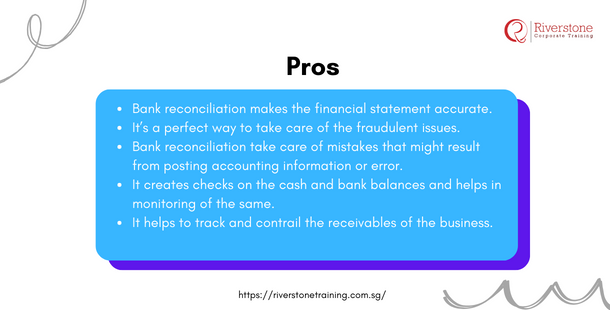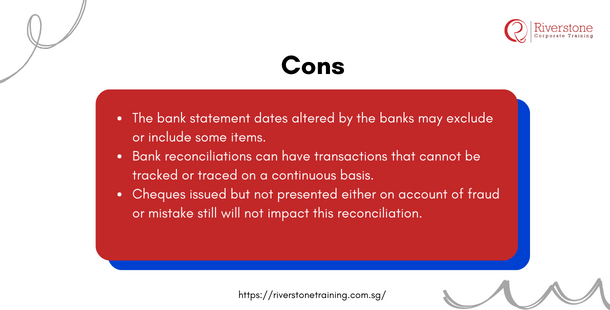
Bank Reconciliation Statement
Bank Reconciliation Statement:
Have you ever had issues with the cash and bank balance? Does it not correspond to the bank statement? You need a bank reconciliation statement. Bank reconciliation statement attempts to explain the difference in cash and bank balances in books of accounts and bank balances in a bank statement. A document reconciles the cash and bank balance in the balance sheet to the corresponding amount on the bank statement. The bank reconciliation statements are useful in identifying the difference in cash and bank balances, detecting frauds, and any cash adjustments. The bank reconciliation statements should be prepared regularly to ensure that cash accounts are free from mistakes and fraud.
Application of Bank Reconciliation Statement
- It is useful in correcting the disparities in the amount of cash and bank balance.
- The bank reconciliation will help identify issues such as,
- Cheque received but not deposited.
- Cheque deposited by not cleared.
- Cheque issued but not cleared.
- Cheque issued but not given.
- Bank charges not recorded in accounting records is a common issue covered in many basic finance courses for beginners.
- Cheque bounced not recorded.
- Interest charged by the bank not recorded.
- Cheque directly deposited by clients not recorded in books.
- Cash deposited in a bank not recorded in books of accounts.
- Other transactions related to expenses, payment and receipt recorded in either bank statement or books of accounts.
- Bank reconciliation is essential for auditors. The auditors will always examine the company’s ending bank reconciliation while doing their audit, contributing to a clearer understanding of auditor opinion in financial statements.
Pros and cons
The bank reconciliation statement has merits and demerits. Let us consider the benefits and the demerits that are associated with the bank reconciliation statement.
Pros:
- Bank reconciliation makes the company financial statement accurate.
- It’s a perfect way to take care of the fraudulent issues.
- Bank reconciliation take care of mistakes that might result from posting accounting information or error.
- It creates checks on the cash and bank balances and helps in monitoring of the same.
- It helps to track and contrail the receivables of the business.
Cons:
Despite the many benefits of bank reconciliation, there are some demerits!
- The bank statement dates altered by the banks may exclude or include some items.
- Bank reconciliations can have transactions that cannot be tracked or traced on a continuous basis.
- Cheques issued but not presented either on account of fraud or mistake still will not impact this reconciliation.
Mastering Bank Reconciliation for SMEs:
Design a step-by-step guide that is very practical in nature to Small and Medium-sized Enterprises (SMEs) in Singapore. This material is to guide them through the whole bank reconciliation procedure including collection of documents (e.g., bank statements of local banks: DBS, UOB, OCBC and internal cash books), reconciliation of differences and corrections. Add typical business situations found in Singapore like direct deposits by a customer, bank fees and GIRO direct deposits. Such visual aids as a flowchart or a downloadable template of a bank reconciliation statement would make this guide extremely helpful and applicable to the local business community. This type of guide aligns well with practical finance courses for SMEs in Singapore and can be enhanced further through custom e-learning content development Singapore to ensure better engagement and accessibility.
How Smart Bank Reconciliation Drives Business Growth:
Change the tone in which there is only the stress on the very fact of compliance, but it is required to explain how carefully planned and prompt bank reconciliation procedure can turn out to be an effective business tool in Singapore. This content may cover how it aids in the optimization of cash flow in making better investment decisions, fraudulent activities that may affect profitability, better accuracy in budgeting of expansion plans, and streamlining the audit process should there be any requirement of funding or merger. Once making strategic benefits stand out and tying it to growth possibilities in the Singaporean market, you will be able to appeal to business owners and financial managers who are interested in using accounting practices as a form of a competitive advantage, especially those who pursue best finance and investment courses for professionals to enhance strategic decision-making for business.
Conclusion
To conclude, a bank reconciliation statement is a useful tool that introduces transparency and efficiency in a business accounting system. It matches the book and the bank balances with bank statement and act as check and balances in the accounting system of the company.



